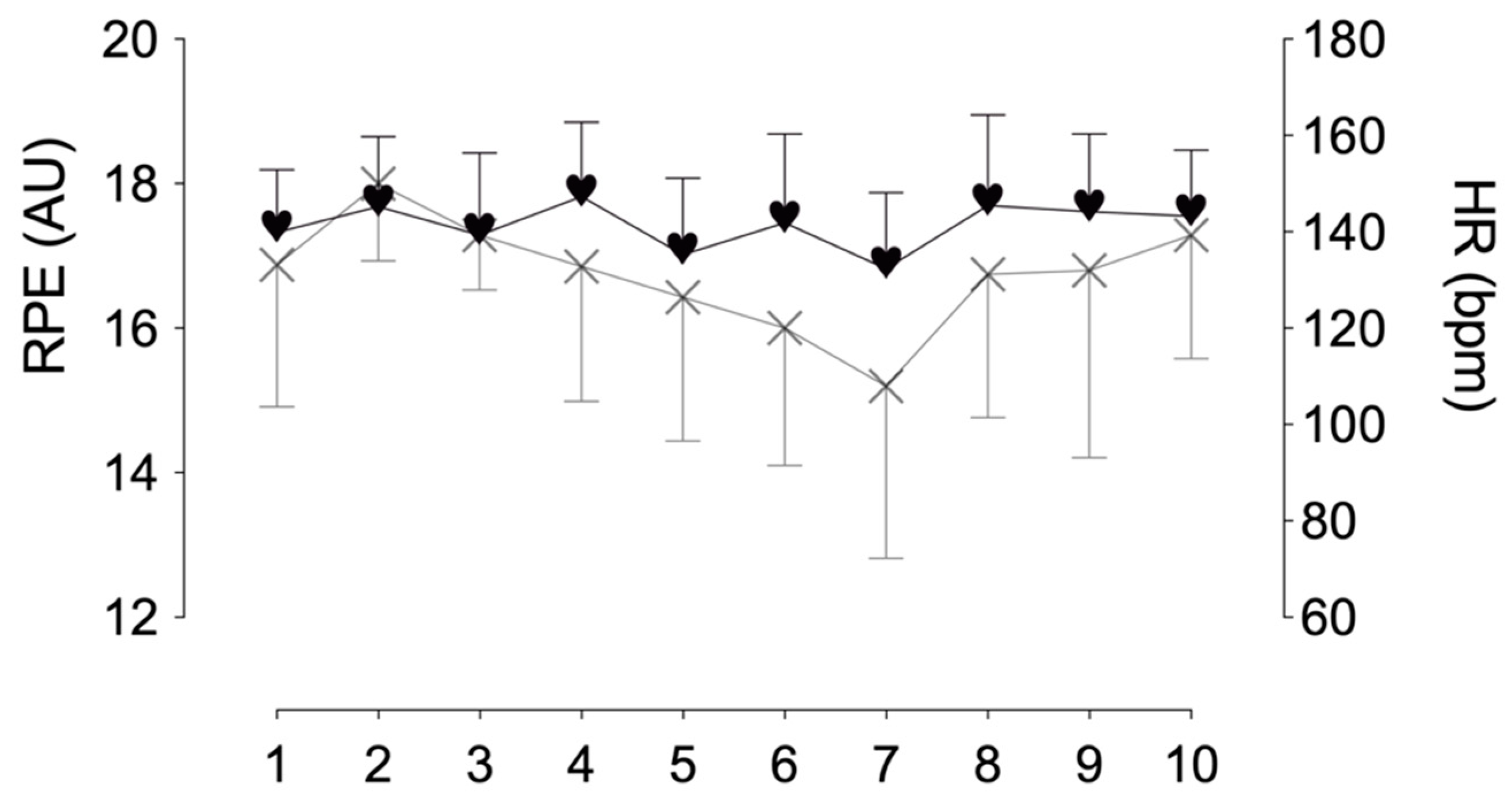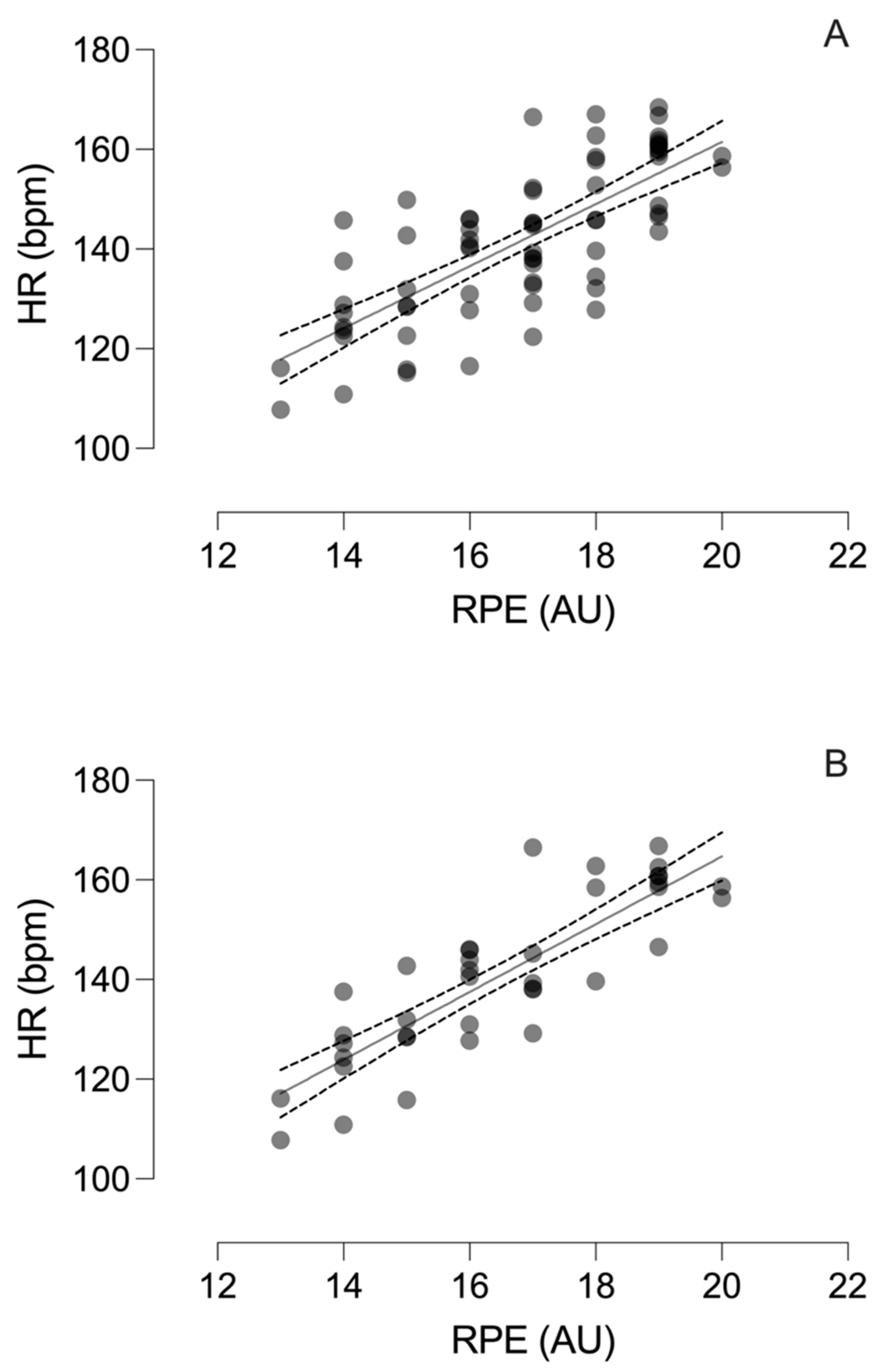Long-Term Analyses of the Rate of Perceived Exertion as an Indicator of Intensity in Women’s Basketball during a Relegation Play-off
Abstract
Simple Summary
Abstract
1. Introduction
2. Materials and Methods
2.1. Experimental Approach to the Problem
2.2. Participants
2.3. Procedure
2.3.1. Pre-Study Familiarisation
2.3.2. Obtaining HR during Training and Competition
2.3.3. Video Recording of Events
2.3.4. Obtaining the Mean HR of the Match
2.3.5. Obtaining the RPE after the Match
2.3.6. Learning Process
2.3.7. Obtaining of Atmospheric Data
2.4. Statistical Analysis
3. Results
4. Discussion
5. Limitations
6. Conclusions
Author Contributions
Funding
Institutional Review Board Statement
Informed Consent Statement
Data Availability Statement
Conflicts of Interest
References
- Candel Campillo, N.; Olmedilla Zafra, A.; Blas Redondo, A. Relaciones entre la práctica de actividad física y el autoconcepto, la ansiedad y la depresión en chicas adolescentes. Cuad. Psicol. Deporte 2008, 8, 61–78. [Google Scholar]
- Mujika, I. The Alphabet of Sport Science Research Starts With Q. Int. J. Sport. Physiol. Perform. 2013, 8, 465–466. [Google Scholar] [CrossRef]
- Arcos, A.L.; Martínez-Santos, R.; Yanci, J.; Mendiguchia, J.; Méndez-Villanueva, A. Negative associations between perceived training load, volume and changes in physical fitness in professional soccer players. J. Sport. Sci. Med. 2015, 14, 394–401. [Google Scholar]
- Sobolewski, E.J. The Relationships between Internal and External Load Measures for Division I College Football Practice. Sports 2020, 8, 165. [Google Scholar] [CrossRef] [PubMed]
- Teixeira, J.E.; Forte, P.; Ferraz, R.; Leal, M.; Ribeiro, J.; Silva, A.J.; Barbosa, T.M.; Monteiro, A.M. Monitoring Accumulated Training and Match Load in Football: A Systematic Review. Int. J. Environ. Res. Public. Health 2021, 18, 3906. [Google Scholar] [CrossRef] [PubMed]
- Bourdon, P.C.; Cardinale, M.; Murray, A.; Gastin, P.; Kellmann, M.; Varley, M.C.; Gabbett, T.J.; Coutts, A.J.; Burgess, D.J.; Gregson, W.; et al. Monitoring Athlete Training Loads: Consensus Statement. Int. J. Sport. Physiol. Perform. 2017, 12, S2161–S2170. [Google Scholar] [CrossRef]
- Maciejczyk, M.; Wiecek, M.; Szymura, J.; Cempla, J.; Wiecha, S.; Szygula, Z.; Brown, L.E. Effect of body composition on respiratory compensation point during an incremental test. J. Strength Cond. Res. 2014, 28, 2071–2077. [Google Scholar] [CrossRef]
- Duggan, J.D.; Moody, J.A.; Byrne, P.J.; Cooper, S.-M.; Ryan, L. Training Load Monitoring Considerations for Female Gaelic Team Sports: From Theory to Practice. Sports 2021, 9, 84. [Google Scholar] [CrossRef]
- Enes, A.; Oneda, G.; Alves, D.L.; Palumbo, D.d.P.; Cruz, R.; Moiano Junior, J.V.M.; Novack, L.F.; Osiecki, R. Determinant Factors of the Match-Based Internal Load in Elite Soccer Players. Res. Q. Exerc. Sport 2021, 92, 63–70. [Google Scholar] [CrossRef]
- Cuadrado-Reyes, J.; Ríos, L.J.C.; Ríos, I.J.C.; Martin-Tamayo, I.; Aguilar-Martínez, D. La percepción subjetiva del esfuerzo para el control de la carga de entrenamiento en una temporada en un equipo de balonmano. Rev. Psicol. Deporte 2012, 21, 331–339. [Google Scholar]
- Calleja-González, J.; Jiménez, C.; Fuentes Azpiroz, M.; Feu, S. Perceived exertion effort in mini basketball players and its relationship with training volume. Rev. Psicol. Deporte 2013, 22, 205–208. [Google Scholar]
- Nunes, J.A.; Costa, E.C.; Viveiros, L.; Moreira, A.; Aoki, M.S. Monitoramento da carga interna no basquetebol. Rev. Bras. Cineantropometria E Desempenho Hum. 2011, 13, 67–72. [Google Scholar] [CrossRef]
- Borg, G.; Linderholm, H. Perceived Exertion and Pulse Rate during Graded Exercise in Various Age Groups. Acta Med. Scand. 1967, 181, 194–206. [Google Scholar] [CrossRef]
- Gómez-Díaz, A.J.; Pallarés, J.G.; Díaz, A.; Bradley, P.S. Quantification of physical and psychological loads: Differences in competitive levels and the effects on match results. Rev. Psicol. Deporte 2013, 22, 463–469. [Google Scholar]
- Iannaccone, A.; Conte, D.; Cortis, C.; Fusco, A. Usefulness of Linear Mixed-Effects Models to Assess the Relationship between Objective and Subjective Internal Load in Team Sports. Int. J. Environ. Res. Public. Health 2021, 18, 392. [Google Scholar] [CrossRef]
- Coutts, A.J.; Rampinini, E.; Marcora, S.M.; Castagna, C.; Impellizzeri, F.M. Heart rate and blood lactate correlates of perceived exertion during small-sided soccer games. J. Sci. Med. Sport 2009, 12, 79–84. [Google Scholar] [CrossRef]
- Casamichana, D.; Castellano, J.; Calleja-Gonzalez, J.; Roman, J.S.; Castagna, C. Relationship between indicators of training load in soccer players. J. Strength Cond. Res. 2013, 27, 369–374. [Google Scholar] [CrossRef]
- Borges, N.R.; Scanlan, A.T.; Reaburn, P.R.; Doering, T.M. A Comparison of Heart Rate Training Load and Perceptual Effort Between Masters and Young Cyclists. Int. J. Sport. Physiol. Perform. 2020, 15, 759–762. [Google Scholar] [CrossRef]
- Rodríguez-Zamora, L.; Engan, H.K.; Lodin-Sundström, A.; Schagatay, F.; Iglesias, X.; Rodríguez, F.A.; Schagatay, E. Blood lactate accumulation during competitive freediving and synchronized swimming. Undersea Hyperb. Med. Soc. 2018, 45, 55–63. [Google Scholar] [CrossRef]
- Nobari, H.; Gholizadeh, R.; Martins, A.D.; Badicu, G.; Oliveira, R. In-Season Quantification and Relationship of External and Internal Intensity, Sleep Quality, and Psychological or Physical Stressors of Semi-Professional Soccer Players. Biology 2022, 11, 467. [Google Scholar] [CrossRef]
- Borg, G.A.V. Psychophysical bases of perceived exertion. Med. Sci. Sport. Exerc. 1982, 14, 377–381. [Google Scholar] [CrossRef]
- Sampaio, J.; Abrantes, C.; Leite, N. Power, heart rate and perceived exertion responses to 3 × 3 and 4 × 4 basketball small-sided games. Rev. Psicol. Deporte 2009, 18, 463–467. [Google Scholar]
- Moreira, A.; McGuigan, M.R.; Arruda, A.F.; Freitas, C.G.; Aoki, M.S. Monitoring Internal Load Parameters During Simulated and Official Basketball Matches. J. Strength Cond. Res. 2012, 26, 861–866. [Google Scholar] [CrossRef]
- World Medical Association. World Medical Association Declaration of Helsinki: Ethical principles for medical research involving human subjects. JAMA 2013, 310, 2191–2194. [Google Scholar] [CrossRef] [PubMed]
- McInnes, S.E.; Carlson, J.S.; Jones, C.J.; McKenna, M.J. The physiological load imposed on basketball players during competition. J. Sport. Sci. 1995, 13, 387–397. [Google Scholar] [CrossRef] [PubMed]
- Field, A. Discovering Statistics Using IBM SPSS Statistics, 5th ed.; SAGE Publications: London, UK, 2017; ISBN 978-1-5264-1952-1. [Google Scholar]
- Hopkins, W.G.; Marshall, S.W.; Batterham, A.M.; Hanin, J. Progressive statistics for studies in sports medicine and exercise science. Med. Sci. Sport. Exerc. 2009, 41, 3–12. [Google Scholar] [CrossRef]
- Navarro, D.; Foxcroft, D.; Faulkenberry, T.J. Learning Statistics with JASP: A Tutorial for Psychology Students and Other Beginners; JASP: Amsterdam, The Netherlands, 2019; p. 418. [Google Scholar]
- Klusemann, M.J.; Pyne, D.B.; Foster, C.; Drinkwater, E.J. Optimising technical skills and physical loading in small-sided basketball games. J. Sport. Sci. 2012, 30, 1463–1471. [Google Scholar] [CrossRef]
- Parfitt, G.; Shepherd, P.; Eston, R.G. Reliability of effort production using the children’s CALER and BABE perceived exertion scales. J. Exerc. Sci. Fit. 2007, 5, 49–55. [Google Scholar]
- Piedra, A.; Caparrós, T.; Vicens-Bordas, J.; Peña, J. Internal and External Load Control in Team Sports through a Multivariable Model. J. Sport. Sci. Med. 2021, 20, 751–758. [Google Scholar] [CrossRef]
- Suárez-Iglesias, D.; Dehesa, R.; Scanlan, A.T.; Rodríguez-Marroyo, J.A.; Vaquera, A. Defensive Strategy and Player Sex Impact Heart-Rate Responses During Games-Based Drills in Professional Basketball. Int. J. Sport. Physiol. Perform. 2021, 16, 360–366. [Google Scholar] [CrossRef]
- Alexiou, H.; Coutts, A.J. A Comparison of Methods Used for Quantifying Internal Training Load in Women Soccer Players. Int. J. Sport. Physiol. Perform. 2008, 3, 320–330. [Google Scholar] [CrossRef] [PubMed]
- Vaquera Jiménez, A. Heart rate response to game-play in professional basketball players. J. Hum. Sport Exerc. 2008, 3, 1–9. [Google Scholar] [CrossRef]
- Ben Abdelkrim, N.; Castagna, C.; El Fazaa, S.; El Ati, J. The Effect of Players’ Standard and Tactical Strategy on Game Demands in Men’s Basketball. J. Strength Cond. Res. 2010, 24, 2652–2662. [Google Scholar] [CrossRef] [PubMed]
- Petway, A.J.; Freitas, T.T.; Calleja-González, J.; Medina Leal, D.; Alcaraz, P.E. Training load and match-play demands in basketball based on competition level: A systematic review. PLoS ONE 2020, 15, e0229212. [Google Scholar] [CrossRef]
- Berkelmans, D.M.; Dalbo, V.J.; Kean, C.O.; Milanović, Z.; Stojanović, E.; Stojiljković, N.; Scanlan, A.T. Heart Rate Monitoring in Basketball: Applications, Player Responses, and Practical Recommendations. J. Strength Cond. Res. 2018, 32, 2383–2399. [Google Scholar] [CrossRef]
- Stojanović, E.; Stojiljković, N.; Scanlan, A.T.; Dalbo, V.J.; Berkelmans, D.M.; Milanović, Z. The Activity Demands and Physiological Responses Encountered During Basketball Match-Play: A Systematic Review. Sport. Med. 2018, 48, 111–135. [Google Scholar] [CrossRef]
- Manzi, V.; D’ottavio, S.; Impellizzeri, F.M.; Chaouachi, A.; Chamari, K.; Castagna, C. Profile of weekly training load in elite male professional basketball players. J. Strength Cond. Res. 2010, 24, 1399–1406. [Google Scholar] [CrossRef]




| Age (Years) | Weight (kg) | Height (cm) | BMI (kg/m2) | Body Fat (%) | Competitive Experience (Years) |
|---|---|---|---|---|---|
| 21.30 ± 2.71 | 68.84 ± 11.21 | 177.00 ± 7.00 | 21.73 ± 2.85 | 20.74 ± 3.51 | 10.00 ± 3.12 |
| Variable | M 1 | M 2 | M 3 | M 4 | M 5 | M 6 | M 7 | M 8 | M 9 | M 10 |
|---|---|---|---|---|---|---|---|---|---|---|
| RPE (AU) | 16.88 ± 1.95 | 18.00 ± 1.07 | 17.29 ± 0.75 | 16.86 ± 1.86 | 16.43 ± 1.99 | 16.00 ± 1.90 | 15.20 ± 2.39 | 16.75 ± 1.98 | 16.80 ± 2.59 | 17.29 ± 1.70 |
| HR (bpm) | 139.90 ± 8.42 | 145.23 ± 9.41 | 139.37 ± 11.63 | 147.33 ± 10.61 | 135.21 ± 10.94 | 141.93 ± 13.46 | 132.35 ± 12.37 | 145.44 ± 12.22 | 144.22 ± 12.59 | 143.28 ± 9.35 |
Publisher’s Note: MDPI stays neutral with regard to jurisdictional claims in published maps and institutional affiliations. |
© 2022 by the authors. Licensee MDPI, Basel, Switzerland. This article is an open access article distributed under the terms and conditions of the Creative Commons Attribution (CC BY) license (https://creativecommons.org/licenses/by/4.0/).
Share and Cite
Batalla-Gavalda, A.; Beltran-Garrido, J.V.; Garrosa-Martín, G.; Cecilia-Gallego, P.; Montoliu-Colás, R.; Corbi, F. Long-Term Analyses of the Rate of Perceived Exertion as an Indicator of Intensity in Women’s Basketball during a Relegation Play-off. Biology 2022, 11, 1592. https://doi.org/10.3390/biology11111592
Batalla-Gavalda A, Beltran-Garrido JV, Garrosa-Martín G, Cecilia-Gallego P, Montoliu-Colás R, Corbi F. Long-Term Analyses of the Rate of Perceived Exertion as an Indicator of Intensity in Women’s Basketball during a Relegation Play-off. Biology. 2022; 11(11):1592. https://doi.org/10.3390/biology11111592
Chicago/Turabian StyleBatalla-Gavalda, Abraham, Jose Vicente Beltran-Garrido, Gerson Garrosa-Martín, Pau Cecilia-Gallego, Raul Montoliu-Colás, and Francisco Corbi. 2022. "Long-Term Analyses of the Rate of Perceived Exertion as an Indicator of Intensity in Women’s Basketball during a Relegation Play-off" Biology 11, no. 11: 1592. https://doi.org/10.3390/biology11111592
APA StyleBatalla-Gavalda, A., Beltran-Garrido, J. V., Garrosa-Martín, G., Cecilia-Gallego, P., Montoliu-Colás, R., & Corbi, F. (2022). Long-Term Analyses of the Rate of Perceived Exertion as an Indicator of Intensity in Women’s Basketball during a Relegation Play-off. Biology, 11(11), 1592. https://doi.org/10.3390/biology11111592









